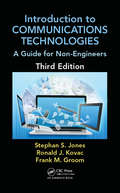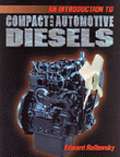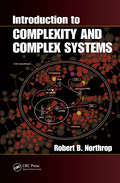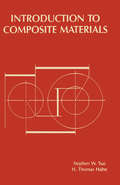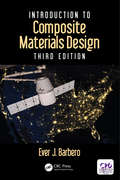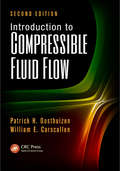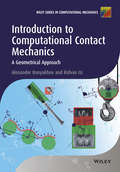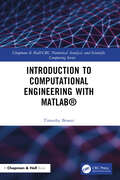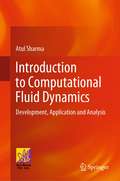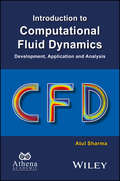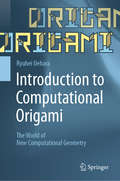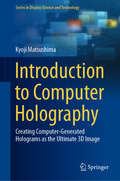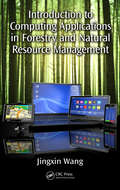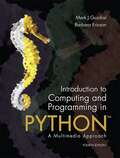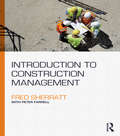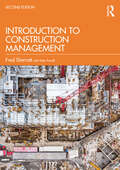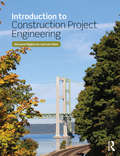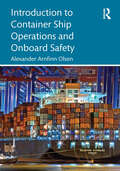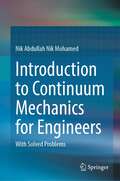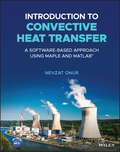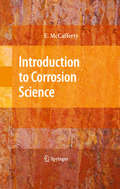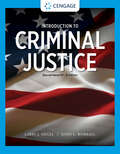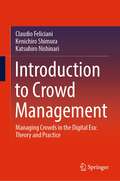- Table View
- List View
Introduction to Communications Technologies: A Guide for Non-Engineers, Third Edition
by Stephan Jones Ronald J. Kovac Frank M. GroomThanks to the advancement of faster processors within communication devices, there has been a rapid change in how information is modulated, multiplexed, managed, and moved. While formulas and functions are critical in creating the granular components and operations of individual technologies, understanding the applications and their purposes in the
Introduction to Compact and Automotive Diesels
by Edward RalbovskyThis book is an excellent introduction to compact and automotive diesel engines. How the engines are used in a variety of equipment is explained in a detailed, yet easy to understand format. Topics of theory, operation, service, diagnosis and troubleshooting of diesel engines make this a practical and valuable resource. The material is geared toward a reader with an understanding of gasoline engines with a need to know about diesel engines. This book will supplement a service manual well with its extensive illustrations from US and foreign manufacturers.
Introduction to Complexity and Complex Systems
by Robert B. NorthropThe boundaries between simple and complicated, and complicated and complex system designations are fuzzy and debatable, even using quantitative measures of complexity. However, if you are a biomedical engineer, a biologist, physiologist, economist, politician, stock market speculator, or politician, you have encountered complex systems. Furthermore
Introduction to Composite Materials
by StephenW. TsaiA widely used basic text by two recognized authorities. A unified and disciplined approach; advanced concepts reduced to easy-to-use charts, formulas and numerical examples.
Introduction to Composite Materials Design (Composite Materials)
by Ever J. BarberoThe Third Edition of Introduction to Composite Materials Design is a practical, design-oriented textbook aimed at students and practicing engineers learning analysis and design of composite materials and structures. Readers will find the Third Edition to be both highly streamlined for teaching, with new comprehensive examples and exercises emphasizing design, as well as complete with practical content relevant to current industry needs. Furthermore, the Third Edition is updated with the latest analysis techniques for the preliminary design of composite materials, including universal carpet plots, temperature dependent properties, and more. Significant additions provide the essential tools for mastering Design for Reliability as well as an expanded material property database.
Introduction to Compressible Fluid Flow (Heat Transfer)
by Patrick H. Oosthuizen William E. CarscallenIntroduction to Compressible Fluid Flow, Second Edition offers extensive coverage of the physical phenomena experienced in compressible flow. Updated and revised, the second edition provides a thorough explanation of the assumptions used in the analysis of compressible flows. It develops in students an understanding of what causes compressible flow
Introduction to Computational Contact Mechanics
by Alexander Konyukhov Ridvan IziIntroduction to Computational Contact Mechanics: A Geometrical Approach covers the fundamentals of computational contact mechanics and focuses on its practical implementation. Part one of this textbook focuses on the underlying theory and covers essential information about differential geometry and mathematical methods which are necessary to build the computational algorithm independently from other courses in mechanics. The geometrically exact theory for the computational contact mechanics is described in step-by-step manner, using examples of strict derivation from a mathematical point of view. The final goal of the theory is to construct in the independent approximation form /so-called covariant form, including application to high-order and isogeometric finite elements. The second part of a book is a practical guide for programming of contact elements and is written in such a way that makes it easy for a programmer to implement using any programming language. All programming examples are accompanied by a set of verification examples allowing the user to learn the research verification technique, essential for the computational contact analysis. Key features: Covers the fundamentals of computational contact mechanics Covers practical programming, verification and analysis of contact problems Presents the geometrically exact theory for computational contact mechanics Describes algorithms used in well-known finite element software packages Describes modeling of forces as an inverse contact algorithm Includes practical exercises Contains unique verification examples such as the generalized Euler formula for a rope on a surface, and the impact problem and verification of thå percussion center Accompanied by a website hosting software Introduction to Computational Contact Mechanics: A Geometrical Approach is an ideal textbook for graduates and senior undergraduates, and is also a useful reference for researchers and practitioners working in computational mechanics.
Introduction to Computational Engineering with MATLAB® (Chapman & Hall/CRC Numerical Analysis and Scientific Computing Series)
by Timothy BowerIntroduction to Computational Engineering with MATLAB® aims to teach readers how to use MATLAB programming to solve numerical engineering problems. The book focuses on computational engineering with the objective of helping engineering students improve their numerical problem-solving skills. The book cuts a middle path between undergraduate texts that simply focus on programming and advanced mathematical texts that skip over foundational concepts, feature cryptic mathematical expressions, and do not provide sufficient support for novices.Although this book covers some advanced topics, readers do not need prior computer programming experience or an advanced mathematical background. Instead, the focus is on learning how to leverage the computer and software environment to do the hard work. The problem areas discussed are related to data-driven engineering, statistics, linear algebra, and numerical methods. Some example problems discussed touch on robotics, control systems, and machine learning.Features: Demonstrates through algorithms and code segments how numeric problems are solved with only a few lines of MATLAB code Quickly teaches students the basics and gets them started programming interesting problems as soon as possible No prior computer programming experience or advanced math skills required Suitable for students at undergraduate level who have prior knowledge of college algebra, trigonometry, and are enrolled in Calculus I MATLAB script files, functions, and datasets used in examples are available for download from http://www.routledge.com/9781032221410.
Introduction to Computational Fluid Dynamics: Development, Application and Analysis
by Atul SharmaThis more-of-physics, less-of-math, insightful and comprehensive book simplifies computational fluid dynamics for readers with little knowledge or experience in heat transfer, fluid dynamics or numerical methods. The novelty of this book lies in the simplification of the level of mathematics in CFD by presenting physical law (instead of the traditional differential equations) and discrete (independent of continuous) math-based algebraic formulations. Another distinguishing feature of this book is that it effectively links theory with computer program (code). This is done with pictorial as well as detailed explanations of implementation of the numerical methodology. It also includes pedagogical aspects such as end-of-chapter problems and carefully designed examples to augment learning in CFD code-development, application and analysis. This book is a valuable resource for students in the fields of mechanical, chemical or aeronautical engineering.
Introduction to Computational Fluid Dynamics: Development, Application and Analysis (Ane/Athena Books)
by Atul SharmaThis book is primarily for a first one-semester course on CFD; in mechanical, chemical, and aeronautical engineering. Almost all the existing books on CFD assume knowledge of mathematics in general and differential calculus as well as numerical methods in particular; thus, limiting the readership mostly to the postgraduate curriculum. In this book, an attempt is made to simplify the subject even for readers who have little or no experience in CFD, and without prior knowledge of fluid-dynamics, heattransfer and numerical-methods. The major emphasis is on simplification of the mathematics involved by presenting physical-law (instead of the traditional differential equations) based algebraic-formulations, discussions, and solution-methodology. The physical law based simplified CFD approach (proposed in this book for the first time) keeps the level of mathematics to school education, and also allows the reader to intuitively get started with the computer-programming. Another distinguishing feature of the present book is to effectively link the theory with the computer-program (code). This is done with more pictorial as well as detailed explanation of the numerical methodology. Furthermore, the present book is structured for a module-by-module code-development of the two-dimensional numerical formulation; the codes are given for 2D heat conduction, advection and convection. The present subject involves learning to develop and effectively use a product - a CFD software. The details for the CFD development presented here is the main part of a CFD software. Furthermore, CFD application and analysis are presented by carefully designed example as well as exercise problems; not only limited to fluid dynamics but also includes heat transfer. The reader is trained for a job as CFD developer as well as CFD application engineer; and can also lead to start-ups on the development of "apps" (customized CFD software) for various engineering applications. "Atul has championed the finite volume method which is now the industry standard. He knows the conventional method of discretizing differential equations but has never been satisfied with it. As a result, he has developed a principle that physical laws that characterize the differential equations should be reflected at every stage of discretization and every stage of approximation. This new CFD book is comprehensive and has a stamp of originality of the author. It will bring students closer to the subject and enable them to contribute to it."—Dr. K. Muralidhar, IIT Kanpur, INDIA
Introduction to Computational Materials Science
by Richard LesarEmphasising essential methods and universal principles, this textbook provides everything students need to understand the basics of simulating materials behaviour. All the key topics are covered from electronic structure methods to microstructural evolution, appendices provide crucial background material, and a wealth of practical resources are available online to complete the teaching package. Modelling is examined at a broad range of scales, from the atomic to the mesoscale, providing students with a solid foundation for future study and research. Detailed, accessible explanations of the fundamental equations underpinning materials modelling are presented, including a full chapter summarising essential mathematical background. Extensive appendices, including essential background on classical and quantum mechanics, electrostatics, statistical thermodynamics and linear elasticity, provide the background necessary to fully engage with the fundamentals of computational modelling. Exercises, worked examples, computer codes and discussions of practical implementations methods are all provided online giving students the hands-on experience they need.
Introduction to Computational Origami: The World of New Computational Geometry
by Ryuhei UeharaThis book focuses on origami from the point of view of computer science. Ranging from basic theorems to the latest research results, the book introduces the considerably new and fertile research field of computational origami as computer science. Part I introduces basic knowledge of the geometry of development, also called a net, of a solid. Part II further details the topic of nets. In the science of nets, there are numerous unresolved issues, and mathematical characterization and the development of efficient algorithms by computer are closely connected with each other. Part III discusses folding models and their computational complexity. When a folding model is fixed, to find efficient ways of folding is to propose efficient algorithms. If this is difficult, it is intractable in terms of computational complexity. This is, precisely, an area for computer science research. Part IV presents some of the latest research topics as advanced problems. Commentaries on all exercises included in the last chapter. The contents are organized in a self-contained way, and no previous knowledge is required. This book is suitable for undergraduate, graduate, and even high school students, as well as researchers and engineers interested in origami.
Introduction to Computer Holography: Creating Computer-Generated Holograms as the Ultimate 3D Image (Series in Display Science and Technology)
by Kyoji MatsushimaThis book covers basic- to expert-level applications in computer holography, a strong candidate for the ultimate 3D display technology. The computer holography developed in the course of the past decade represents the basis of wave optics. Accordingly, the book presents the basic theory of wave optics and practical techniques for handling wave fields by means of the fast Fourier transform. Numerical techniques based on polygons, as well as mask-based techniques, are also presented for calculating the optical fields of virtual 3D models with occlusion processing. The book subsequently describes simulation techniques for very large-scale optical fields, and addresses the basics and concrete applications of simulation, offering a valuable resource for readers who need to employ it in the context of developing optical devices. To aid in comprehension, the main content is complemented by numerous examples of optical fields and photographs of reconstructed 3D images.
Introduction to Computing Applications in Forestry and Natural Resource Management
by Jingxin WangDue to the complexity of operational forestry problems, computing applications are becoming pervasive in all aspects of forest and natural resource management. This book provides a comprehensive introduction to computers and their applications in forest and natural resource management and is designed for both undergraduate and graduate students in forestry and natural resources. It introduces state-of-the-art applications for several of the most important computer technologies in terms of data acquisition, data manipulation, basic programming techniques, and other related computer and Internet concepts and applications. This book consists of six parts and 19 chapters.
Introduction to Computing and Programming In Python: A Multimedia Approach
by Barbara Ericson Mark GuzdialThis book is a uniquely researched and up-to-date volume that is widely recognized for its successful introduction to the subject of Media Computation. Emphasizing creativity, classroom interaction, and in-class programming examples, the book takes a bold and unique approach to computation that engages students and applies the subject matter to the relevancy of digital media. <p><p> The Fourth Edition teaches students to program in an effort to communicate via social computing outlets, providing a unique approach that serves the interests of a broad range of students. Key Topics: Introduction to Computer Science and Media Computation; Introduction to Programming; Creating and Modifying Text; Modifying Pictures Using Loops; Picture Techniques with Selection; Modifying Pixels by Position; Modifying Sounds Using Loops; Modifying Samples in a Range; Making Sounds by Combining Pieces; Building Bigger Programs; Manipulating Text with Methods and Files; Advanced Text Techniques: Web and Information; Making Text for the Web; Creating and Modifying Movies; Speed; Functional Programming; Object Oriented Programming. <p><p> This book is useful for anyone interested in learning computer programming.
Introduction to Construction Management
by Fred SherrattManagement in the construction industry is a complex task, with team members often undertaking hazardous work, complying with stacks of regulations and legal requirements, and under the constant threat of plans going awry, however there is no need for all construction management textbooks to be so complicated. Starting with a general overview of the industry, Introduction to Construction Management is the beginner’s guide to key concepts, terms, processes and practices associated with modern construction management in the UK. Supported by diagrams, illustrations and case studies, this book explores construction management from a variety of perspectives, including: Production management Commercial management Quality management Health and Safety management Environmental management Also incorporated are important industry trends including sustainability, corporate social responsibility, and the advent of BIM. This is the most approachable text available for anyone starting to learn about construction management, at HNC/HND, FdSc, or BSc level.
Introduction to Construction Management
by Fred SherrattIntroduction to Construction Management, Second Edition, is the beginner’s guide to key concepts, terms, processes and practices associated with modern construction management. The new edition has been fully updated with new data, case studies and enhancements and remains the most practical and accessible book on the subject available. Significant new topics have been added including construction ethics, coverage of mental health and wellbeing in the industry, project delivery and Construction 4.0, to make this the most cutting-edge book available for students on construction and engineering management courses. Supported by diagrams, illustrations and case studies, the book starts with a general introduction to the industry and covers the relevant management theory before providing applied coverage of: Production management Commercial management Quality management Health and Safety management Environmental management This is the most approachable text available for anyone starting to learn about construction management at any level.
Introduction to Construction Project Engineering
by Len Holm Giovanni C. MigliaccioThis new textbook fills an important gap in the existing literature, in that it prepares construction engineering and built environment students for their first experience of the jobsite. This innovative book integrates conceptual and hands-on knowledge of project engineering to introduce students to the construction process and familiarize them with the procedures and activities they need to operate as project engineers during their summer internships and immediately after graduation. The textbook is structured into four sections: Section A: Introductory Concepts Section B: Field Engineering Section C: Office Engineering Section D: Advanced Project Engineering The emphasis on field tasks and case studies, questions, and exercises taken from across civil works and commercial building sectors makes this the ideal textbook for introductory to intermediate courses in Construction Engineering, Construction Engineering Technology, Civil and Architectural Engineering, and Construction Management degree programs.
Introduction to Container Ship Operations and Onboard Safety
by Alexander Arnfinn OlsenIntroduction to Container Ship Operations and Onboard Safety is an introduction for students and professionals involved in the maritime industry. It provides an overview of the merchant navy from its beginnings to the present day, entry and training requirements, shipboard hierarchy and roles and responsibilities, shipboard safety organisation, inductions and new crew member familiarisation, safe means of access to enclosed spaces, general housekeeping, risk assessment and risk management. In addition, it examines specific hazardous activities such as cargo loading and unloading, drydocking, drills, and actions to take in the event of an emergency. This textbook provides a concise overview of core concepts and practices in the maritime industry that is appropriate for the cadet, experienced seafarer, industry professional, and the general maritime enthusiast.
Introduction to Continuum Mechanics for Engineers: With Solved Problems
by Nik Abdullah MohamedThis textbook provides an overview of the fundamental concepts in continuum mechanics for application in real material behavior analysis. The contents cover basic topics such as Kinematics—the motion of any material point representing a material body using the Lagrangian and Eulerian approaches; stress tensors—stress analysis of material bodies experiencing small deformations; mathematical modeling of material properties in continuum mechanics; balance principles—transfer of specific mechanical properties from a system to its environment or vice-versa through the system boundary. The textbook also contains pedagogical elements such as worked examples and end-of-chapter exercises which are derived from typical engineering problems, and the solution manual so that students can solve computational problems by running simulations on Matlab or Python on their own. This benefits engineering students understand the concept of continuum mechanics for future analysis using finite-element analysis, boundary element method or any other computational methods.
Introduction to Convective Heat Transfer: A Software-Based Approach Using Maple and MATLAB
by Nevzat OnurINTRODUCTION TO CONVECTIVE HEAT TRANSFER A highly practical intro to solving real-world convective heat transfer problems with MATLAB® and MAPLE In Introduction to Convective Heat Transfer, accomplished professor and mechanical engineer Nevzat Onur delivers an insightful exploration of the physical mechanisms of convective heat transfer and an accessible treatment of how to build mathematical models of these physical processes. Providing a new perspective on convective heat transfer, the book is comprised of twelve chapters, all of which contain numerous practical examples. The book emphasizes foundational concepts and is integrated with explanations of computational programs like MATLAB® and MAPLE to offer students a practical outlet for the concepts discussed within. The focus throughout is on practical, physical analysis rather than mathematical detail, which helps students learn to use the provided computational tools quickly and accurately. In addition to a solutions manual for instructors and the aforementioned MAPLE and MATLAB® files, Introduction to Convective Heat Transfer includes: A thorough introduction to the foundations of convective heat transfer, including coordinate systems, and continuum and thermodynamic equilibrium concepts Practical explorations of the fundamental equations of laminar convective heat transfer, including integral formulation and differential formulation Comprehensive discussions of the equations of incompressible external laminar boundary layers, including laminar flow forced convection and the thermal boundary layer concept In-depth examinations of dimensional analysis, including the dimensions of physical quantities, dimensional homogeneity, and dimensionless numbers Ideal for first-year graduates in mechanical, aerospace, and chemical engineering, Introduction to Convective Heat Transfer is also an indispensable resource for practicing engineers in academia and industry in the mechanical, aerospace, and chemical engineering fields.
Introduction to Corrosion Science
by Edward MccaffertyThe text emphasizes basic principles of corrosion science which underpin extensions to practice. The emphasis here is on corrosion in aqueous environments, although a chapter on high temperature oxidation has been included. The overall effort has been to provide a brief but rigorous introduction to corrosion science without getting mired in extensive individual case histories, specific engineering applications, or complications of practical corrosion data.
Introduction to Criminal Justice (Mindtap Course List Series)
by Larry J. Siegel John L. WorrallTake a close look at the intriguing concepts, policies and processes at work in today's criminal justice system with Siegel/Worrall's best-selling INTRODUCTION TO CRIMINAL JUSTICE, 17E. Known for trusted, solidly researched content, this reader-friendly presentation examines the impact of recent events, such as the coronavirus pandemic, racial unrest and publicized shootings, on contemporary crime and the criminal justice system. <p><p>This edition is packed with provocative, high-profile examples and the latest developments and trends—from new crime-countering technology to efforts in criminal justice reform. Inviting narratives, vivid illustrations, fascinating cases and special topic features delve into the intricate workings behind policing, courts and correctional systems. You examine issues such as stereotyping, recent scandals and the implications of court decisions and career options as you gain a better understanding of the challenges and opportunities within criminal justice.
Introduction to Crowd Management: Managing Crowds in the Digital Era: Theory and Practice
by Katsuhiro Nishinari Claudio Feliciani Kenichiro ShimuraThis book will guide you in a simple and illustrative way through all aspects related to crowd behaviour, including sociological theories, methods of crowd control, people detection and tracking, and crowd simulation and prediction, while examining previous accidents to learn from the past. Crowds are a constant presence in most cities around the globe and mass gatherings are attracting an increasing number of people. While experience can help manage large crowds and plan mass events, knowledge on crowd behaviour is fundamental for successfully dealing with unexpected situations, improving current practices and implementing state-of-the-art technologies in management strategies. After letting people laugh about the controversy on colliding pedestrians, with this book, two of the Ig Nobel laureates on pedestrian traffic will make you think (and learn) presenting through a collaborative approach, combining theoretical with practical advice, the science behind crowd dynamics and the importance it plays in our increasingly urbanized society. Fundamental aspects related to crowd management are presented using simple concepts requiring little or no knowledge of mathematics or engineering. Professionals involved in pedestrian traffic, as well as students and researchers entering the field of crowd dynamics, will find this book a useful interdisciplinary introduction on the subject, exploring both fundamental background information and more specific topics related to crowd management.
Introduction to Crowd Science
by G Keith StillThis well-grounded and practical guide highlights the underlying causes of crowd disasters and mass fatalities-giving readers insight into the root causes of crowd-related accidents. It presents a clearer understanding of crowd dynamics and provides the reader with fundamental modeling techniques to plan and manage and improve crowd safety in places of public assembly. The book is written for students and professionals in a number of areas such as event planning, licensing/approval, and event operation, including emergency services.
